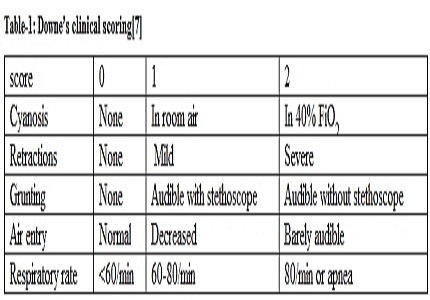Incidence, clinicalprofile and outcome of transient tachypnea of newborn
Abstract
Introduction: Respiratory distress is a common problem in neonates necessitating admission. Transient tachypnea of newborn (TTNB) is most common after term cesarean delivery. It is characterized by the early onset of tachypnea with retractions, or expiratory grunting and, occasionally, cyanosis. Distinguishing the disease from respiratory distress syndrome (RDS) andother respiratory disorders may be difficult, and TTNB is frequently a diagnosis of exclusion; the distinctive features of TTNB are rapid recovery of the infant and the absence of radiographic findings for RDS (hypoaeration, diffusereticulogranular pattern, air bronchograms) and other lung disorders.
Objective: To study incidence, clinical profile of TTNB and to identify clinical clues that may help inprediction of severity of disease and need for early intervention for better outcome in patients with TTNB.
Study design: This is a prospective study conducted at a tertiary care institute in late preterm and term babies admitted in neonatal intensive care unit (NICU) with respiratory distress during the study period.
Results: Total admissions during study period were 510 of which 22 Newborns had TTNB. The average gestational age of 36+ 1.2 weeks and birth weight of 2924 + 404 gm. Neonates were included in the study following inclusion criteria. Risk factors identified for TTNB includes caesarean section (most common), male sex, infant of diabetic mother. Outcome can be predicted based, on Downe’s score at presentation and time of development of respiratory distress after birth.
Conclusion: According to this study all late preterm and term newborn delivered through LSCS are at greater risk for developing TTNB and early development of respiratory distress and higher Downe’s score at presentation are associated with longer hospital stay.
Downloads
References
2. Avery MAE, Gatewood, Brumley, TNB, possible delayed respiration of fluid at birth Am j dis child 1996;111(4);380385. [PubMed]
3. Gowen CW Jr, Lawson EE, Gingras J, Boucher RC, Gatzy JT, Knowles MR. Electrical potential difference and ion transport across nasal epithelium of term neonates: correlation with mode of delivery, transient tachypnea of the newborn, and respiratory rate. J Pediatr. 1988 Jul;113(1 Pt 1):121-7. [PubMed]
4. ClohertyJP, Eichenwald EC, Hansen AR, StrakAR. Manual of neonatal care 5th ed.Philadelphia, PA; Lippincott Williams & Wilkins 2012; P403-07.
5. Yurdakok M, Ozek E. Transient tachypnea of the newborn: the treatment strategies. Curr Pharm Des. 2012;18(21):3046-9. [PubMed]
6. Liem JJ, Huq SI, Ekuma O, et al: Transient tachypnea of the newborn may be an early clinical manifestation of wheezing symptoms, J Pediatr 151:29–33, 2007. DOI:10.1016/j.jpeds.2007.02.021.
7. Anita Rusmawati, Ekawati L. Haksari, Roni Naning. Downes score as a clinical assessment for hypoxemia in neonates with respiratory distress. Paediatr Indones. 2008;48:342-5. DOI : dx.doi.org/10.14238/pi48.6.2008.342-5.
8. Tutdibi E, Gries K, Bücheler M, Misselwitz B, Schlosser RL, Gortner L. Impact of labor on outcomes in transient tachypnea of the newborn: population-based study. Pediatrics. 2010 Mar;125(3):e577-83. doi: 10.1542/peds.2009-0314. Epub 2010 Feb 15.
9. Hack, M., Fanaroff, A. A., Klaus, M. H., Mendelawitz, B. D., &Merkatz, I. R. (1976). Neonatal respiratory distress following elective delivery. A preventable disease?. American journal of obstetrics and gynecology, 126(1), 43-47. DOI: http://dx.doi.org/10.1016/0002-9378(76)90462-2.
10. Kolås T, Saugstad OD, Daltveit AK, Nilsen ST, Øian P. Planned cesarean versus planned vaginal delivery at term: comparison of newborn infant outcomes. Am J Obstet Gynecol. 2006 Dec;195(6):1538-43. Epub 2006 Jul 17.
11. Guglani L, Lakshminrusimha S, Ryan RM. Transient tachypnea of the newborn. Pediatr Rev. 2008 Nov;29(11):e59-65. doi: 10.1542/pir.29-11-e59. [PubMed]
12. Weintraub AS, Cadet CT, Perez R, DeLorenzo E, Holzman IR, Stroustrup A. Antibiotic use in newborns with transient tachypnea of the newborn. Neonatology. 2013;103(3):235-40. doi: 10.1159/000346057. Epub 2013 Feb 14. [PubMed]
13. Lewis, V., and Andrew Whitelaw. "Furosemide for transient tachypnea of the newborn." Cochrane Database Syst Rev 1 (2002);(1);CD003064. [PubMed]
14. Takaya, Akane, Miwa Igarashi, Mizue Nakajima, Hidehiko Miyake, Yoshio Shima, and Shunji Suzuki. "Risk factors for transient tachypnea of the newborn in infants delivered vaginally at 37 weeks or later." Journal of Nippon Medical School 75, no. 5 (2008): 269-273. DOI :doi.org/10.1272/jnms.75.269.
15. Bassey G, Inimgba NM. Fetomaternal out come of twinge station in Port Harcourt, South-South, Nigeria. Niger J Med.2014 Oct-Dec;23(4):282-7. [PubMed]
16. Kasap B, Duman N, Ozer E, Tatli M, Kumral A, Ozkan H. Transient tachypnea of the newborn: predictivefactor for prolongedtachypnea. Pediatr Int. 2008 Feb;50(1):81-4. doi: 10.1111/j.1442-200X.2007.02535.x.
17. Dilekkahvecioglu, U Fukcakir,DuranYildiz, Serdar Alan, Omer Erdeve, Begum Atasay, Saadet Arsan. Transienttachypnea of newborn is there bedside clues for predicting the need of ventilation a support? Turkishjournal of paediatrics 2016:58:400-405.DOI :10.24953/turkjped.2016.04.009.
18. Shashidhar A, Suman Rao PN, Joe Jose. Downes Score vs. Silverman Anderson Score for Assessment of Respiratory Distress in Preterm Newborns. Pediatric Oncall [serial online] 2016[cited 2016 July-September 1]; 13. Art #30. Available from:http://www.pediatriconcall.com/pediatric-journal/View/fulltext-articles/1027/J/0/0/542/0. DOI: 10.7199/ped.oncall.2016.30.

Copyright (c) 2017 Author (s). Published by Siddharth Health Research and Social Welfare Society

This work is licensed under a Creative Commons Attribution 4.0 International License.


 OAI - Open Archives Initiative
OAI - Open Archives Initiative


